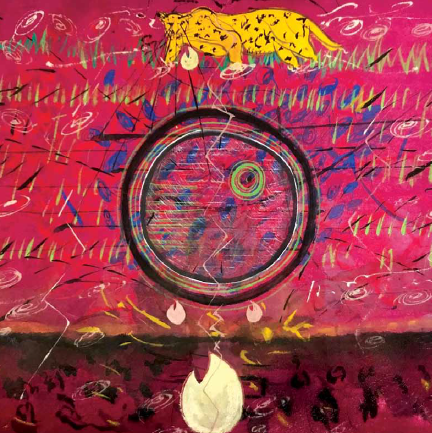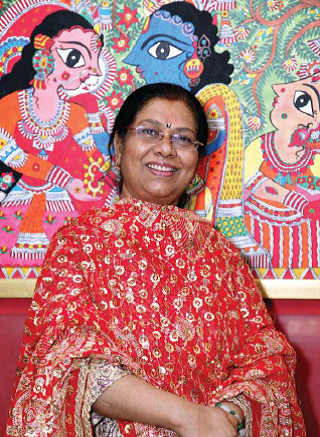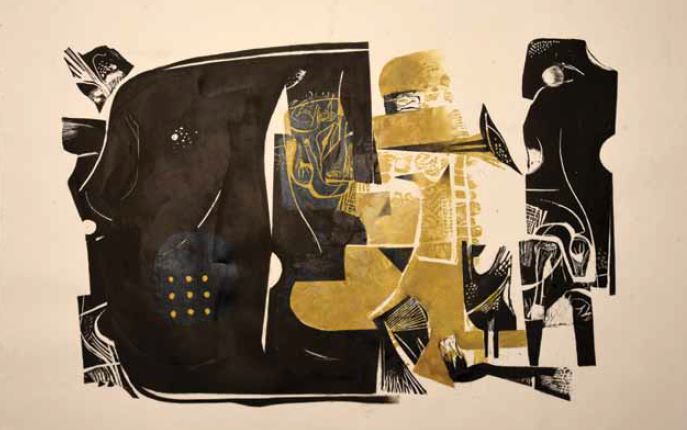
Calling his art experimental, acclaimed artist Niladri Paul says he loves mystery and uncertainty in his work and weaving a visual poetry of beguiling pigments
My first encounter with Niladri Paul, who is undoubtedly one of our finest artists today, was not planned per se. Both of us attended the Government College of Arts and Crafts, Kolkata, and would occasionally bump into each other. Niladri was my junior and we soaked in the same artistic environment and learnt similar techniques. Guided by stellar artists like Bikash Bhattacharya, Ashesh Mitra, Niranjan Pradhan, Isha Mahammad and also seniors like Chitravanu Mazumder and Subrata Gangopadhhaya, art was the binding force for us. However, I got acquainted with Niladri’s art later on when both of us settled in Delhi and I would frequent his studio every now and then. Born and brought up in Jamshedpur, Niladri had been painting for as long as he remembers, even before he knew it was called “art’’. From the moment he could hold a pencil, Niladri started doodling on anything he could lay his hands on, right from paper to walls, much to the dismay of his parents. He recalls, “While in the bathroom, I used to enjoy drawing on walls. Eventually, my father started taking interest in my art and encouraged me to participate in various art competitions. Winning awards as a kid inspired me to pursue art vigorously. Pictures of comic books fascinated me and I would copy pictures for practise.” Recalling his earliest brush with an artist, he says, “There used to be Sengupta Sir near our home in Jamshedpur. The pipe smoking, hat-wearing Sengupta Sir’s studio was a storehouse of European style paintings,” Niladri recollects. “I used to be awestruck watching the artworks and would grill him on various aspects of the paintings. The wonderland that his studio was, it motivated and convinced me to spur onward on my journey into the world of art,” admits Niladri, drifting into the times gone by. Encouraged, he joined art classes at Rabindra Bhawan at Jamshedpur, where he learnt painting and clay modelling. But this was of little use since only the basics were taught and poster colours were the order of the day. This was the time Niladri decided to embark on a journey to explore the art world independently. But as luck would have it, 15-year-old Niladri had to accompany his mother to Kolkata as she was seriously ill and admitted to PG Hospital near Victoria Memorial. One day, while exploring the city, he visited Indian Museum where he found many youngsters practising pencil drawings of the ancient sculptures displayed in the museum galleries. “I felt curious and luckily, I chanced upon one of my friends there. Apparently, they were preparing for the entrance test to the Government. College of Art and Craft, which is there in the building adjacent to the museum,” shares Niladri. He went to enquire about the admission process and happened to meet artist Ashesh Mitra, who advised him to appear for the admission test and make arrangements for living in the city if he qualified for the five years course. He qualified and in 1981, got admission in the prestigious college but unfortunately, Niladri lost his mother. However, his pursuit of academics in fine art took off and he started living in the college boys’ hostel at Pathuriaghata. “With no fans and proper toilets, hostel life was gruelling,” says Niladri. “I would spend most of my time sketching and painting outdoors. My favourite jaunt was Nimtala Ghat. But for night sketches, I would trundle to Sonagachi with friends. This was the red light area and I loved to capture the colourful night environment there.” In fact, in his later works, this influence is very dominant and women have been a constant muse to Niladri. His fascination for the myriad colours and mystery of women has been almost perpetual in his works. His love for the female form is evident in his portraiture and their complex emotional expression. As a student, he explored the city walking alone and evolving his expression. Like most of us, Niladri, too, was fascinated by the British style – watercolour legacy of our college. However, he would experiment and explore varied techniques gradually mastering most possibilities. He spent initial years honing his skill as an abstract figurative artist with an urge to search for his own distinctive style and medium. Early in college, Niladri started freelancing for advertising agencies. At the same time, he participated in the Calcutta Art fair where two of his watercolours were sold – a night sketch of Sonagachi and Durga Bhasaan (immersion of goddess durga). After completing the Bachelor’s course in 1988, Niladri headed back to Jamshedpur and bagged an assignment from Tata Steel to design inhouse journals. Though well-paid, the job and life in Jamshedpur was lacklustre. “After living in Kolkata for almost seven years, I felt Jamshedpur was not meant for me,” reveals the artist. Later, while he was travelling to Bali via Delhi on an assignment for Tata Steel, the visa for his travel got delayed and he decided to stay back and explore the city. Within two days, he found a job with a local advertising agency as a commercial artist. “Around 1989, I finally decided to settle down in Delhi,” recalls Niladri. While working for prestigious ad agencies, like Ogilvy and Mathers, Clarion etc., he used lunch breaks and after office hours to continue his artistic pursuits. It was during this time that he approached Aurobindo Art Gallery near Hauz Khas with his watercolour paintings. The gallerists agreed to keep a few works, which were sold out. This encouraged him to work independently and he quit his job. “Though it was a huge risk at that point of time, I just picked the gauntlet and went for full time art practice,” he adds.
As a child, Niladri loved to doodle on everything, much to the dismay of his parents. His love for art pushed him to pursue this as his profession.
During the mid-90s when “acrylic” colours hit the market, Niladri was thrilled by its similarity to watercolours. He was never too interested in oil on canvas though he did some oil works mostly in Alla Prima technique. He wanted to explore possibilities with acrylic, but handling acrylic was tough and he spent a lot of time trying out styles, colours, papers and canvases. That was a year of struggle and self-search with wasted materials and hours of learning process and continuous practise. “I used to buy long canvas rolls, made small pieces and continued my experiment day after day to achieve a style of my own,” reveals Niladri. He tasted success with one of his first solo shows of acrylic works. The entire lot of 25 works was lapped up. Though selling boosted his confidence, for him bliss was communicating his ideas to the viewers who liked his works. Early success led him to have a show of portraits in oil and watercolour at World Trade Centre, Singapore in 1994, followed by a string of solo shows in Delhi and Mumbai. In 1996, he participated in the Coconut Grove show held in Miami, Florida. He has held shows across the globe right from Delhi, Mumbai, Kolkata, Chennai to the USA, London, Lagos, South Africa and several other places. His works are in proud collections of big corporate offices and avid art collectors. He was awarded a Senior Fellowship by the Ministry of Culture, Government of India in 2015-16.
Talking about his art, he loves mystery and uncertainty and weaving a visual poetry of beguiling pigments. He likes to call his art experimental, for it is an ongoing evolution of his sensibilities that he endeavours to translate onto his canvases. His love for abstract figurative expressionism though realism is visible in his work. He was inspired by the works of Bikash Bhattacharya and loves Tyeb Mehta’s work. A fan of Paul Klee and Gustav Klimt, he has been inspired by masters like Rembrandt, Van Dyke, Sir Henry Raeburn, Ingres, J.L.David, Dali, William McGregor Paxton and William Adolphe Bouguereau. He has merged acrylic with a hint of drawing, leaving white spaces just like the watercolour method. In fact, he loves to express through colour perspective more than drawing perspective with perfect visual calculation. Niladri believes he has his own style and identity that is evident in all his works. He admits, “I can see my impression, my temperament in my every creation”. He believes any new work gently shapes up on its own “almost effortlessly”.
It is hardly surprising that the artist is equally at ease with his abstract as well as figurative fluid compositions. Freedom and spontaneity have always been important for him, be it personal space or work. This aspect reflects abundantly in cheerful optimism, sheer vibrance and raw energy in his body of work. He does not believe to be a social critique of his times and believes an artist’s language should be simple and forthright, easily understood and relatable. He loves to be rhythmic in conversation, a language that is spontaneous, not a planned layout.
Delhi’s rich cultural life and Niladri’s love for performing arts reflect on the large canvases in enigmatic portraits and dynamic abstracts. Bright blue and orange dominate the palette as he paints with bold strokes and finishing touches of black and white. The audience is drawn to his work because his works are easy to read. The luminescent forms make him mould his very own language of colours, lines, motifs, textures and strokes. A language that is not overtly intellectual or pretentious, but earthy, identifiable, rooted and yet fanciful. It is his positive energy, youthfulness and effervescence that creates the poetic sensibility on the canvas with great ease and yet does not lose the virtuosity of the classic grounding, unique synthesis of control evolving dramatic narrative through extravagant brush strokes.
A non-conformist, maverick, free spirited and bohemian, Niladri, is so like his paintings. Just when a particular series gets a standing ovation, he starts experimenting with something entirely different, least bothered about pandering to the marketing diktats. He comes up with a brand-new series of paintings every now and then with a distinctive palette. He is also a sculptor, photographer, experimenting with interiors and fashion as well – not leaving these mediums unexplored! Photography comes as a useful reference for him sometimes for his paintings.
Niladri mostly confines himself to his studio but sometimes he can be found in the kitchen, where he rustles up spectacular gourmet meals for friends and family. Perfectionism is his forte in whatever he does and compassion is his driving force in life. He invokes spirituality through the resurrection of colours and huesthat magnetically draw one’s attention to the mesmerising nature of his art. Especially the semi realistic human form and the luminosity that have been enthralling. This allows the viewers to experience oneness with the presence of awareness and their being, appreciating peace, love and happiness all melting into a beautiful melody.
“I try to embrace the tangible force into an equally forceful energy in pigments and forms as the ever broadening and growing idiom add to my very own unconstrained palette, thus translating the concentric energy of rhythm, sound and expression into a euphoria on canvas,” Niladri explains. The central premise of his paintings being a celebration of the eternal, ethereal ideals on a metaphysical level in the current urban milieu corresponds to the larger-than-life philosophy of all of us living our lives in complex and mysterious layers. Niladri has studiously refused to let any societal darkness, enter his exclusive world of happy colours. He captures the mood and spirit of his subject’s drawing inspiration from everyday life and the fleeting thought of the moment. And yes, he refuses to write reams of theory about his work.
“My art is not a social critique of our times, as I strongly feel that I am an artist and my language ought to be simple and forthright enough for everybody to understand and relate to.”









 " >
" >
 " >
" >